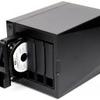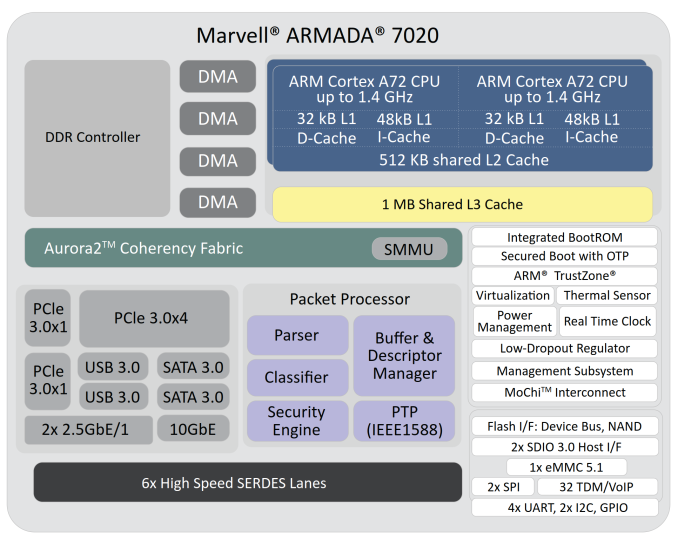NAS Explained
Asustor AS4004T
The Asustor AS4004T can house four hard drives or SSDs (all fit in the same drive caddy). This NAS unit is tied to two Gigabit Ethernet jacks, meaning 1000 / 8 minus QOS and random overhead like error-correction is roughly a maximum of 100 to 125 MB/sec on a single Gigabit Ethernet connection.
However, the new 10 GbE connector multiplies that by tenfold, 10000 / 8 minus QOS and random overhead like error-correction, could, in theory, offer you a maximum of 1000 to 1250 MB/sec on a single 10 Gigabit Ethernet connection. There's more to it than the 10 Gbps jack though, you'll need a storage device(s) that can handle such speeds, as well as an optimized OS, the memory and processor to handle all that File IO.
The storage units, these can be set up in Single disk, JBOD, RAID 0, RAID 1, RAID 5, RAID 6, RAID 10. Once you have installed your hardware, you'll need to bind the NAS to your Ethernet with a CAT5e or with 10 Gbps a 6e cable to a compatible switch; the Asustor NAS offers more connectors though including USB 3.1. When you have your HDDs installed, and the device connected through your PC you'll need to start-up a software suite to bind and set up your configuration. Please look at the install CD for that. Or if you have a smartphone, simply use a smartphone app like FING and scan the network, Asustor will show up with a corresponding IP. Type the IP into your browser and you can start setting up the unit.
- CPU: Marvell ARMADA-7020 1.6GHz (Dual-Core) Processor
- Memory: 2GB DDR4
- Memory Expandable up to: not expandable
- HDD: 4 x SATA3 6Gb/s; 3.5"/2.5" HDD/SSD
- Maximum Internal Raw Capacity: 48 TB (12 TB HDD X 4, Capacity may vary by RAID types)
- Maximum Drive Bays with Expansion Unit: 12
- Maximum Raw Capacity with Expansion Units : 144 TB (12 TB HDD X 12, Capacity may vary by RAID types)
- Expansion: USB 3.1 Gen-1 x2
- Network: Gigabit Ethernet x 2; 10Gigabit Ethernet x1
- PCIe Expansion Slots: 10GbE Built-in
- Output: N/A
- System Fan: 120mm x 1
- Power Supply Unit / Adapter: 90W x1
- Input Power Voltage: 100V to 240V AC
- Certification: FCC, CE, VCCI, BSMI, C-TICK
Operating system compatibility wise the NAS supports file sharing across Linux, UNIX, Mac, and Windows platforms. We will be testing with Windows 8.1 and 10. Also for the more advanced among you, Windows AD (Active Directory) is supported to help create an easy-to-access environment. SSH login and web page SSL login enables users to transfer, store, and share data securely. Since this product acts as a server, ALL PC's within your network can connect to it, with or without access rights.
| File Storage Capacity by Bits and Bytes | ||||
| Byte | Kilobyte | Megabyte | Gigabyte | |
| Kilobyte | 1,024 | 1 | 1,024 | 1,048,576 |
| Megabyte | 1,048,576 | 1,024 | 1 | 1,024 |
| Gigabyte | 1,073,741,824 | 1,048,576 | 1,024 | 1 |
| Terabyte | 1,099,511,627,776 | 1,073,741,824 | 1,048,576 | 1,024 |
| Petabyte | 1,125,899,906,842,620 | 1,099,511,627,776 | 1,073,741,824 | 1,048,576 |
| Exabyte | 1,152,921,504,606,850,000 | 1,125,899,906,842,620 | 1,099,511,627,776 | 1,073,741,824 |
| Zettabyte | 1,180,591,620,717,410,000,000 | 1,152,921,504,606,850,000 | 1,125,899,906,842,620 | 1,099,511,627,776 |
So we passed the Terabyte marker. With our hefty demand in storage capabilities, the industry had to constantly adapt and introduce new features in hardware. Storage units got much bigger in volume over the year, 6 TB HDDs have just been introduced onto the market with 10 TB already in the pipeline. In that line of storage solutions there is one product series growing fast and now reaching SOHO and consumer based markets. They are called NAS units, Network Attached Storage. And there has been a lot of development in these nifty little boxes. Pretty much they are little servers that can hook onto your network and then function as file-servers. The NAS units are often small, do not use a lot of power compared to, say, your PC, but they are highly configurable, offer redundancy as some models can even handle RAID internally. Network Attachable Storage units are among the most advanced home servers available on the market today. Products feature multiple HDD setups, partitions, RAID, USER and USERGROUP based access, FTP, web server, MySQL, hot swappable drives; these are just some of the features that a NAS unit can handle. And though expensive, a product like this is just too darn handy when it comes to file-storage and management over your network.


